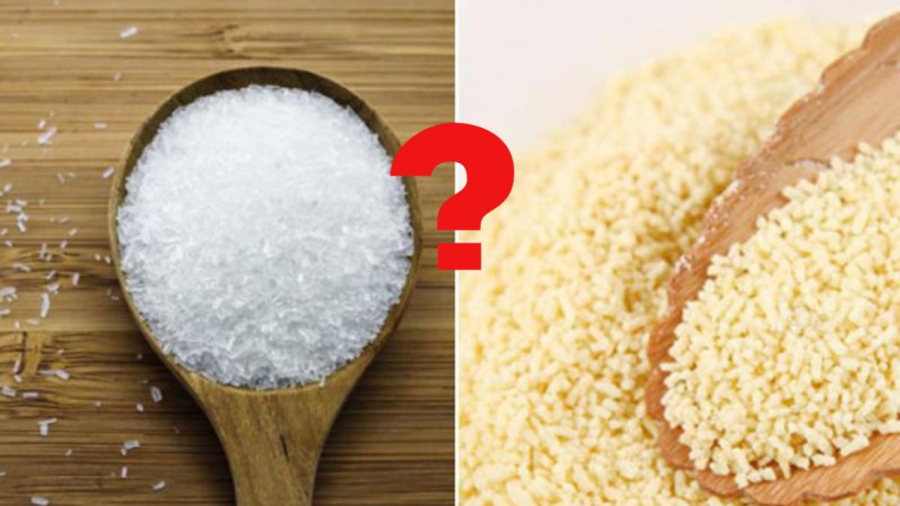What is MSG?
MSG is a type of glutamic acid, an amino acid found in various natural foods. Chemically, MSG is a white crystalline powder similar to salt or sugar. It combines sodium and glutamic acid.
Glutamic acid performs many functions in the body, such as protein synthesis. Glutamic acid is a precursor to the neurotransmitter gamma-aminobutyric acid (GABA). GABA is abundant in the nervous system and plays an important role in inhibition, or soothing signals.
Glutamic acid is naturally present in our bodies and is found in many types of foods. Nowadays, MSG is produced through the fermentation process of starch, sugar beets, sugarcane…
When a protein containing glutamic acid is broken down, for example through fermentation, it becomes glutamate. Glutamate activates taste receptors, creating a savory, sweet taste known as umami.
MSG – monosodium glutamate is the most widely used food additive in industrial food processing and home cooking.
Most of the food we eat on a daily basis contains glutamate, such as meat, fish, eggs, milk, seafood, fruits, and vegetables… Therefore, we have all absorbed this substance through various types of food. And glutamate has the natural property of bringing a sweet, delicious taste to the food.
According to Associate Professor Nguyen Thi Lam, former Deputy Director of the National Institute of Nutrition, due to the main component of MSG being glutamate, a common amino acid that makes up protein in living organisms. MSG has umami taste, also known as meaty taste, which makes food delicious and enhances the flavor.

What is “Hạt Nêm”?
“Hạt Nêm” contains many ingredients, among which the indispensable ones are MSG (flavor enhancer 621) and 2 flavor enhancers 627 and 631 (also known as super MSG with sweetness 10-15 times higher than regular MSG).
The sweetness of “Hạt Nêm” mainly comes from these flavor enhancers, not from “bone broth and meat” as often advertised (if any, it would be meat powder, not condensed from bone broth and meat because the finished product would spoil quickly and be difficult to preserve at room temperature).
All 3 flavor enhancers 621, 627, and 631 are in the list of food additives permitted to be used in food, but if used excessively, they are not really good for health and can cause unpredictable side effects.

Which one should you use, “Hạt Nêm” or MSG?
If we only consider the nutritional aspect, both MSG and “Hạt Nêm” are not necessary to supplement in the daily diet.
In fact, “Hạt Nêm” is no better than MSG, because it itself contains MSG (monosodium glutamate) in its ingredients, as well as the super MSG.
It is best for consumers to limit both types. But if you still use them, you need to consider:
Compared to “Hạt Nêm”, MSG seems to be “more natural” when considering the ingredient composition. “Hạt Nêm” with a “complex” composition makes it more difficult for consumers to grasp and control safety.
When using “Hạt Nêm”, besides creating a sweet taste for the dish, it also adds a salty taste. Using too much “Hạt Nêm” can make users overlook the habit of adding additional salt to their food, which can gradually lead to iodine deficiency.
When using MSG, note that normal cooking temperatures do not cause MSG to transform into harmful substances for health. However, if using MSG to marinate grilled food, you should grill at temperatures below 250 degrees Celsius. At higher temperatures, MSG can be transformed into harmful substances for the body.
“Hạt Nêm” is a seasoning product that contains multiple ingredients, primarily MSG (flavor enhancer 621) and two additional flavor enhancers, 627 and 631, known for their intense sweetness. The sweet taste of “Hạt Nêm” is derived from these additives, and it also contributes a salty flavor to dishes.
- Composition: MSG is primarily made of monosodium glutamate, while “Hạt Nêm” contains a mix of ingredients, including MSG and super MSG (flavor enhancers 627 and 631)
- Taste: Both enhance savory flavors, but “Hạt Nêm” also adds sweetness and saltiness to dishes.
- Nutritional Value: Neither MSG nor “Hạt Nêm” offer significant nutritional benefits, and excessive consumption may have negative health effects.
- Safety: MSG is generally considered safe at normal cooking temperatures, but high temperatures (above 250°C) can transform it into harmful substances. “Hạt Nêm”, with its complex composition, may be less predictable in terms of safety.
From a nutritional standpoint, neither MSG nor “Hạt Nêm” are necessary in the daily diet. “Hạt Nêm”, due to its additional ingredients, may be less preferred as it contains super MSG, which has an extremely high sweetness level. Both should be consumed in moderation, but if a choice must be made, MSG appears to be the “more natural” option with a simpler, more predictable composition.






































